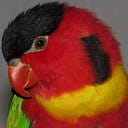Do pufferfishes hold their breath when inflated?
A newly-published study by a team of Australian scientists reveals that inflated pufferfish do not hold their breath — refuting a common widespread belief
by GrrlScientist for The Guardian | @GrrlScientist
When harassed, a pufferfish rapidly gulps water (or air) into its stomach, transforming itself into a prickly beach-ball that’s three or four times larger than the deflated fish. They inflate to avoid being swallowed by predators. But does an inflated pufferfish breathe? Most people think inflated pufferfish hold their breath, and compensate for oxygen debt by absorbing oxygen directly through their skin. But a newly-published study by a team of Australian scientists shows that idea is wrong, revealing that the gills are the primary site of respiration for inflated pufferfish. The researchers also found that even though inflated pufferfish consume as much as five times more oxygen than when they are resting, they do not compensate for their increased energetic demands by absorbing oxygen through their skin.
I ran across a fun little paper the other day in Biology Letters, one of my favourite scientific journals. The authors asked whether pufferfish hold their breath when they’re inflated — a question that only curious minds might ponder.
After seeing the film, Finding Nemo, Georgia McGee, a curious mind and an Honours Student at James Cook University in Townsville, Australia, was inspired to ask just this question. According to Ms McGee, breath-holding could make inflation an energetically-demanding behaviour since pufferfish can remain puffed up for “tens of minutes”. Further, as Ms McGee reasoned, if pufferfish do hold their breath whilst inflated, then this “inflation response” would necessarily be limited in duration; its upper limit determined by the length of time it takes pufferfishes to run out of oxygen.
A search of the scientific literature revealed that although most scientists assumed that pufferfish hold their breath whilst inflated, no one knew this for certain. Intrigued, Ms McGee decided to find out. Under the supervision of Timothy Clark, a research scientist at the Australian Institute of Marine Science at James Cook University, Ms McGee designed an experiment to answer this question.
Using a hand-net, Ms McGee captured wild black-saddled pufferfish, Canthigaster valentini, on coral reefs at Lizard Island Research Station and on the Great Barrier Reef near Cairns, Australia. She moved the fish into the lab, and allowed them to acclimate to captivity. After a month of aquarium life, Ms McGee measured pufferfish respiration (oxygen consumption rates) when the fish were resting and during inflation (Figure 1):
The measurements showed that inflated pufferfish respiration rates initially increased fivefold above resting levels, but declined rapidly throughout the inflation period, which lasted between 3.7–18.0 minutes. Upon deflation, the team did not measure any discernible dip in respirometer oxygen levels that would indicate that oxygen had been extracted from ingested water via the stomach. When the team used a suction cup to attach the respirometer directly to the pufferfish skin, they still did not measure any discernible difference in oxygen. Further, the pufferfish gills were always moving during the inflation response.
Taken together, these data show that pufferfishes rely on their gills to obtain oxygen, even whilst inflated into a prickly ball. Further, it is the act of inflation itself, where the pufferfish rapidly gulps large amounts of water (or air) into its stomach, that is energetically demanding, and results in a substantial oxygen debt.
Which component of the inflation response creates the pufferfish’s oxygen debt? The authors propose that the muscles that close off each end of the pufferfish’s expansile stomach are the most energetically demanding, and tire after several inflation events.
“It is possible that the gradual fatigue of the muscles controlling the oesophageal and pyloric sphincters could limit the duration of inflation”, the authors write in their paper.
As Bloat, the porcupine pufferfish, asked at the end of Finding Nemo: “Now what?”
“We are currently working on a second paper stemming from Georgia’s honours project, which focuses on understanding how the inflation response of pufferfishes may respond to warming ocean temperatures”, replied Dr Clark in email.
Sources:
McGee G.E. & Clark T.D. (2014). All puffed out: do pufferfish hold their breath while inflated? Biology Letters, 10 (12) doi:10.1098/rsbl.2014.0823
Enjoy my writing? Please click on the green heart in the left corner to recommend this piece. Follow me on Medium for more like this.
.. .. .. .. .. .. .. .. .. .. .. .. .. .. .. .. .. .. .. .. .. .. .. .. .. .. .. .. .. .. .. .. .. .. .. .. .. .. .. .. .. .. ..
GrrlScientist is very active on twitter @GrrlScientist and you can follow all her writing by subscribing to her TinyLetter
Originally published at The Guardian on 4 December 2014.
